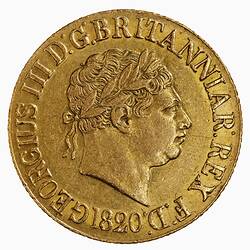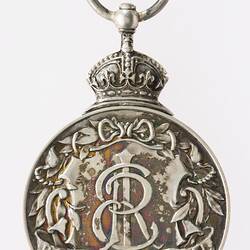Summary
Gold coin; Denomination: Double-florin
Royal Mint, London
Queen Victoria (1837-1901)
A double-florin is a 4 shilling coin. Struck as part of a new coinage introduced for the Golden Jubilee of Queen Victoria, 1837-1887. The coins all shared a new obverse of the Queen, adapted from Boehm's own Jubillee medal. Both the new head and the new double-florin denomination proved unpopular. The head was replaced in 1893 and the denomination only struck until 1889. The reverse design was adapted from the 5 guinea coin of Queen Anne. The florin had been introduced in 1849 as a step towards decimalization of the coinage, it was a tenth of a pound.
Obverse Description
Bust of the Queen facing left the small wearing imperial crown, long veil falling behind her head, pearl necklace and earring, Ribbon and Star of the Garter and the badge of the Imperial Order of India; in small raised letters on the bust truncation, the artist's initials J.E.B. (Joseph Edgar Boehm); around, VICTORIA D:G: BRITT: REG: F:D:
Reverse Description
Four crowned shields arranged to form a cross about the Star of the Garter, top and bottom bear the arms of England, right Scotland, left, Ireland; between the shields are four sceptres, two surmounted with an orb, one with a thistle and one with a harp; around, BRITT: REG: 1888 FID: DEF:, the date being divided by the crown above the top English shield.
Edge Description
milled
More Information
-
Collecting Areas
-
Acquisition Information
Transfer from National Gallery of Victoria (NGV), Mr Alfred Chitty, 15 Mar 1976
-
Date Issued
1888 AD
-
Issued By
-
Mint
-
Artist
-
Denomination
-
Material
Silver
-
Axis
12
-
Classification
-
Category
-
Discipline
-
Type of item
-
Overall Dimensions
36 mm (Outside Diameter), 22.707 g (Weight)
-
Shape
Round
-
References
[Book] Skingley, Philip. 2007. Coins of England and the United Kingdom., Spink 3923 Pages








